Zhan Ma
WIPES: Wavelet-based Visual Primitives
Aug 18, 2025Abstract:Pursuing a continuous visual representation that offers flexible frequency modulation and fast rendering speed has recently garnered increasing attention in the fields of 3D vision and graphics. However, existing representations often rely on frequency guidance or complex neural network decoding, leading to spectrum loss or slow rendering. To address these limitations, we propose WIPES, a universal Wavelet-based vIsual PrimitivES for representing multi-dimensional visual signals. Building on the spatial-frequency localization advantages of wavelets, WIPES effectively captures both the low-frequency "forest" and the high-frequency "trees." Additionally, we develop a wavelet-based differentiable rasterizer to achieve fast visual rendering. Experimental results on various visual tasks, including 2D image representation, 5D static and 6D dynamic novel view synthesis, demonstrate that WIPES, as a visual primitive, offers higher rendering quality and faster inference than INR-based methods, and outperforms Gaussian-based representations in rendering quality.
Perception-Oriented Latent Coding for High-Performance Compressed Domain Semantic Inference
Jul 02, 2025Abstract:In recent years, compressed domain semantic inference has primarily relied on learned image coding models optimized for mean squared error (MSE). However, MSE-oriented optimization tends to yield latent spaces with limited semantic richness, which hinders effective semantic inference in downstream tasks. Moreover, achieving high performance with these models often requires fine-tuning the entire vision model, which is computationally intensive, especially for large models. To address these problems, we introduce Perception-Oriented Latent Coding (POLC), an approach that enriches the semantic content of latent features for high-performance compressed domain semantic inference. With the semantically rich latent space, POLC requires only a plug-and-play adapter for fine-tuning, significantly reducing the parameter count compared to previous MSE-oriented methods. Experimental results demonstrate that POLC achieves rate-perception performance comparable to state-of-the-art generative image coding methods while markedly enhancing performance in vision tasks, with minimal fine-tuning overhead. Code is available at https://github.com/NJUVISION/POLC.
GoLF-NRT: Integrating Global Context and Local Geometry for Few-Shot View Synthesis
May 26, 2025Abstract:Neural Radiance Fields (NeRF) have transformed novel view synthesis by modeling scene-specific volumetric representations directly from images. While generalizable NeRF models can generate novel views across unknown scenes by learning latent ray representations, their performance heavily depends on a large number of multi-view observations. However, with limited input views, these methods experience significant degradation in rendering quality. To address this limitation, we propose GoLF-NRT: a Global and Local feature Fusion-based Neural Rendering Transformer. GoLF-NRT enhances generalizable neural rendering from few input views by leveraging a 3D transformer with efficient sparse attention to capture global scene context. In parallel, it integrates local geometric features extracted along the epipolar line, enabling high-quality scene reconstruction from as few as 1 to 3 input views. Furthermore, we introduce an adaptive sampling strategy based on attention weights and kernel regression, improving the accuracy of transformer-based neural rendering. Extensive experiments on public datasets show that GoLF-NRT achieves state-of-the-art performance across varying numbers of input views, highlighting the effectiveness and superiority of our approach. Code is available at https://github.com/KLMAV-CUC/GoLF-NRT.
Depth-Guided Bundle Sampling for Efficient Generalizable Neural Radiance Field Reconstruction
May 26, 2025Abstract:Recent advancements in generalizable novel view synthesis have achieved impressive quality through interpolation between nearby views. However, rendering high-resolution images remains computationally intensive due to the need for dense sampling of all rays. Recognizing that natural scenes are typically piecewise smooth and sampling all rays is often redundant, we propose a novel depth-guided bundle sampling strategy to accelerate rendering. By grouping adjacent rays into a bundle and sampling them collectively, a shared representation is generated for decoding all rays within the bundle. To further optimize efficiency, our adaptive sampling strategy dynamically allocates samples based on depth confidence, concentrating more samples in complex regions while reducing them in smoother areas. When applied to ENeRF, our method achieves up to a 1.27 dB PSNR improvement and a 47% increase in FPS on the DTU dataset. Extensive experiments on synthetic and real-world datasets demonstrate state-of-the-art rendering quality and up to 2x faster rendering compared to existing generalizable methods. Code is available at https://github.com/KLMAV-CUC/GDB-NeRF.
3D Gaussian Adaptive Reconstruction for Fourier Light-Field Microscopy
May 19, 2025Abstract:Compared to light-field microscopy (LFM), which enables high-speed volumetric imaging but suffers from non-uniform spatial sampling, Fourier light-field microscopy (FLFM) introduces sub-aperture division at the pupil plane, thereby ensuring spatially invariant sampling and enhancing spatial resolution. Conventional FLFM reconstruction methods, such as Richardson-Lucy (RL) deconvolution, exhibit poor axial resolution and signal degradation due to the ill-posed nature of the inverse problem. While data-driven approaches enhance spatial resolution by leveraging high-quality paired datasets or imposing structural priors, Neural Radiance Fields (NeRF)-based methods employ physics-informed self-supervised learning to overcome these limitations, yet they are hindered by substantial computational costs and memory demands. Therefore, we propose 3D Gaussian Adaptive Tomography (3DGAT) for FLFM, a 3D gaussian splatting based self-supervised learning framework that significantly improves the volumetric reconstruction quality of FLFM while maintaining computational efficiency. Experimental results indicate that our approach achieves higher resolution and improved reconstruction accuracy, highlighting its potential to advance FLFM imaging and broaden its applications in 3D optical microscopy.
Efficient LiDAR Reflectance Compression via Scanning Serialization
May 14, 2025Abstract:Reflectance attributes in LiDAR point clouds provide essential information for downstream tasks but remain underexplored in neural compression methods. To address this, we introduce SerLiC, a serialization-based neural compression framework to fully exploit the intrinsic characteristics of LiDAR reflectance. SerLiC first transforms 3D LiDAR point clouds into 1D sequences via scan-order serialization, offering a device-centric perspective for reflectance analysis. Each point is then tokenized into a contextual representation comprising its sensor scanning index, radial distance, and prior reflectance, for effective dependencies exploration. For efficient sequential modeling, Mamba is incorporated with a dual parallelization scheme, enabling simultaneous autoregressive dependency capture and fast processing. Extensive experiments demonstrate that SerLiC attains over 2x volume reduction against the original reflectance data, outperforming the state-of-the-art method by up to 22% reduction of compressed bits while using only 2% of its parameters. Moreover, a lightweight version of SerLiC achieves > 10 fps (frames per second) with just 111K parameters, which is attractive for real-world applications.
Ultra Lowrate Image Compression with Semantic Residual Coding and Compression-aware Diffusion
May 13, 2025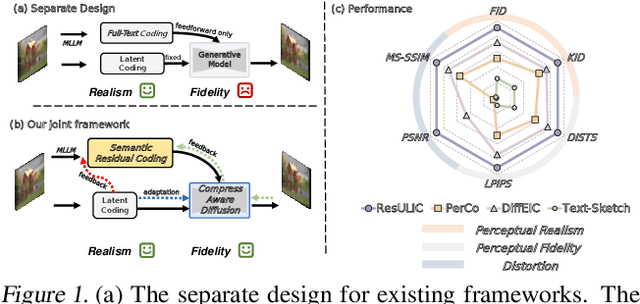

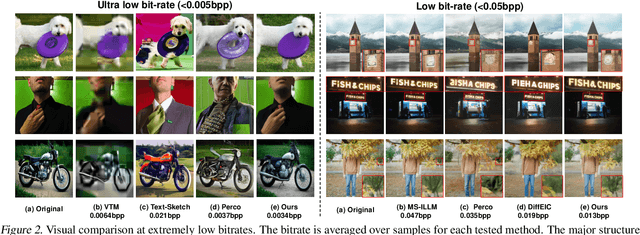
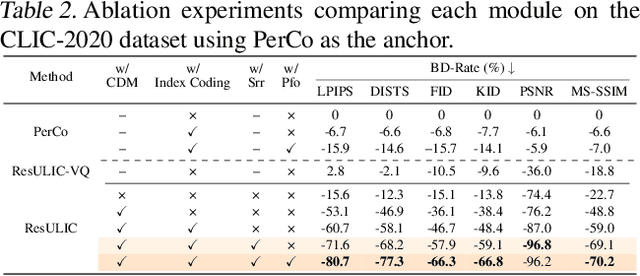
Abstract:Existing multimodal large model-based image compression frameworks often rely on a fragmented integration of semantic retrieval, latent compression, and generative models, resulting in suboptimal performance in both reconstruction fidelity and coding efficiency. To address these challenges, we propose a residual-guided ultra lowrate image compression named ResULIC, which incorporates residual signals into both semantic retrieval and the diffusion-based generation process. Specifically, we introduce Semantic Residual Coding (SRC) to capture the semantic disparity between the original image and its compressed latent representation. A perceptual fidelity optimizer is further applied for superior reconstruction quality. Additionally, we present the Compression-aware Diffusion Model (CDM), which establishes an optimal alignment between bitrates and diffusion time steps, improving compression-reconstruction synergy. Extensive experiments demonstrate the effectiveness of ResULIC, achieving superior objective and subjective performance compared to state-of-the-art diffusion-based methods with - 80.7%, -66.3% BD-rate saving in terms of LPIPS and FID. Project page is available at https: //njuvision.github.io/ResULIC/.
RENO: Real-Time Neural Compression for 3D LiDAR Point Clouds
Mar 16, 2025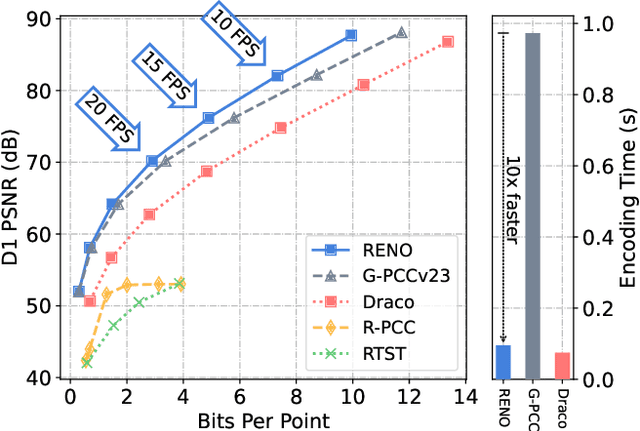
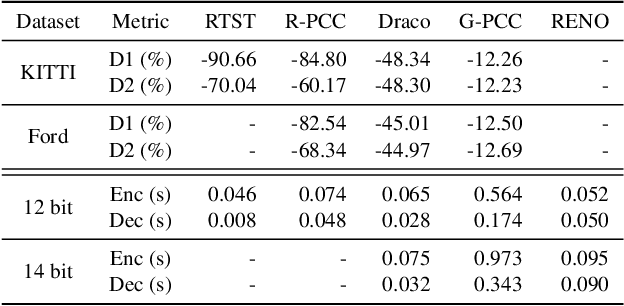
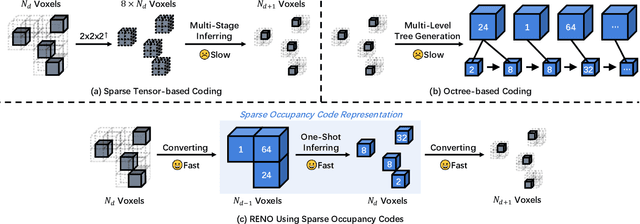
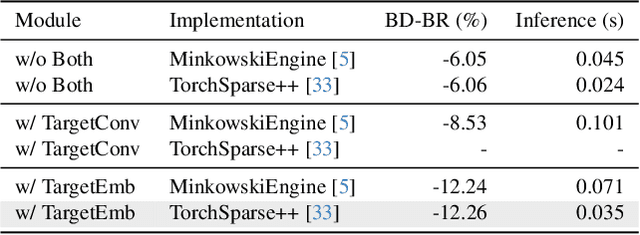
Abstract:Despite the substantial advancements demonstrated by learning-based neural models in the LiDAR Point Cloud Compression (LPCC) task, realizing real-time compression - an indispensable criterion for numerous industrial applications - remains a formidable challenge. This paper proposes RENO, the first real-time neural codec for 3D LiDAR point clouds, achieving superior performance with a lightweight model. RENO skips the octree construction and directly builds upon the multiscale sparse tensor representation. Instead of the multi-stage inferring, RENO devises sparse occupancy codes, which exploit cross-scale correlation and derive voxels' occupancy in a one-shot manner, greatly saving processing time. Experimental results demonstrate that the proposed RENO achieves real-time coding speed, 10 fps at 14-bit depth on a desktop platform (e.g., one RTX 3090 GPU) for both encoding and decoding processes, while providing 12.25% and 48.34% bit-rate savings compared to G-PCCv23 and Draco, respectively, at a similar quality. RENO model size is merely 1MB, making it attractive for practical applications. The source code is available at https://github.com/NJUVISION/RENO.
DreamInsert: Zero-Shot Image-to-Video Object Insertion from A Single Image
Mar 13, 2025Abstract:Recent developments in generative diffusion models have turned many dreams into realities. For video object insertion, existing methods typically require additional information, such as a reference video or a 3D asset of the object, to generate the synthetic motion. However, inserting an object from a single reference photo into a target background video remains an uncharted area due to the lack of unseen motion information. We propose DreamInsert, which achieves Image-to-Video Object Insertion in a training-free manner for the first time. By incorporating the trajectory of the object into consideration, DreamInsert can predict the unseen object movement, fuse it harmoniously with the background video, and generate the desired video seamlessly. More significantly, DreamInsert is both simple and effective, achieving zero-shot insertion without end-to-end training or additional fine-tuning on well-designed image-video data pairs. We demonstrated the effectiveness of DreamInsert through a variety of experiments. Leveraging this capability, we present the first results for Image-to-Video object insertion in a training-free manner, paving exciting new directions for future content creation and synthesis. The code will be released soon.
Mitigating Ambiguities in 3D Classification with Gaussian Splatting
Mar 11, 2025Abstract:3D classification with point cloud input is a fundamental problem in 3D vision. However, due to the discrete nature and the insufficient material description of point cloud representations, there are ambiguities in distinguishing wire-like and flat surfaces, as well as transparent or reflective objects. To address these issues, we propose Gaussian Splatting (GS) point cloud-based 3D classification. We find that the scale and rotation coefficients in the GS point cloud help characterize surface types. Specifically, wire-like surfaces consist of multiple slender Gaussian ellipsoids, while flat surfaces are composed of a few flat Gaussian ellipsoids. Additionally, the opacity in the GS point cloud represents the transparency characteristics of objects. As a result, ambiguities in point cloud-based 3D classification can be mitigated utilizing GS point cloud as input. To verify the effectiveness of GS point cloud input, we construct the first real-world GS point cloud dataset in the community, which includes 20 categories with 200 objects in each category. Experiments not only validate the superiority of GS point cloud input, especially in distinguishing ambiguous objects, but also demonstrate the generalization ability across different classification methods.
 Add to Chrome
Add to Chrome Add to Firefox
Add to Firefox Add to Edge
Add to Edge